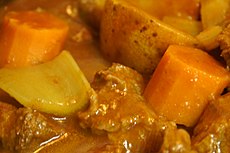Lobscouse
 | |
| Type | Stew |
|---|---|
| Region or state | Northern Europe |
| Main ingredients | Meat, potatoes, occasionally other root vegetables and spices |
Lobscouse(orlapskaus) is a thickScandinavianstewmade ofmeatandpotatoes.[1][2]
Background[edit]
There are many variations oflapskaus.The dish may be made of fresh or leftover meat (usuallybeeforlamb,but sometimes alsochicken,pork,orham) and potatoes. Other typical ingredients arevegetables(such ascarrots,onions,leeks,celery root,andrutabaga), spices (such aspepperorginger),salt,andherbs.[2][3]
Lapskausis possibly linked (historically and etymologically) tolobscouse,a European sailors' stew or hash strongly associated with major ports such asLiverpool.Similar dishes include theDanishlabskovs,Swedishlapskojs,Finnishlapskoussi,or theGermanLabskaus.[3][4]
The dish also figures inNorwegian Americancuisine.[2]In 1970, lapskaus was part of "the official menu for the seamen's mess" of theNorwegian America Line.[3]Until the 1980s,Brooklyn'sEighth Avenue(particularly between 50th and 60th streets) was known as "Lapskaus Boulevard"in reference to the high Norwegian-American population in the area.[5][6][7]
See also[edit]
- Hash (food)– Culinary dish of chopped meat, potatoes, and fried onions
- Scouse (food)– Stew made from meat, potatoes and onion
- Lobby (food)– Stew made from chicken, beef, and potato
References[edit]
- ^"Lapskaus: a Hearty Norwegian Stew".Nordic Nibbler.November 8, 2010.RetrievedMarch 1,2020.
- ^abcSandvold, Irene O. (2011).Gudrun's Kitchen: Recipes from a Norwegian Family.et al.Wisconsin Historical Society Press.pp. 87–89.
- ^abcChotzinoff Grossman, Anne; Grossman Thomas, Lisa (1997).Lobscouse & Spotted Dog: Which It's a Gastronomic Companion to the Aubrey/Maturin Novels.W.W. Norton. pp. 18–19.
- ^"Lobscouse".Nordic Diner.February 11, 2016.RetrievedMarch 1,2020.
- ^"Lapskaus Boulevard, a tale about Norwegians in Brooklyn, NY".transparent. November 7, 2011.RetrievedMarch 1,2020.
- ^Yarrow, Andrew L. (March 17, 1991)."In Brooklyn, Wontons, Not Lapskaus".The New York Times.
- ^Benardo, Leonard; Weiss, Jennifer (2006).Brooklyn by Name: How the Neighborhoods, Streets, Parks, Bridges, and More Got Their Names.New York University Press.p. 145.
Further reading[edit]
- Lurie, April (2009).Dancing in the Streets of Brooklyn.Dell Yearling.ISBN978-0385729420.
- Scott, Astrid Karlsen (2011).Authentic Norwegian Cooking.Skyhorse Publishing.ISBN978-0963433978.
- Sinclair, Charles Gordon (1998).International Dictionary of Food and Cooking.Routledge.ISBN978-1579580575.
